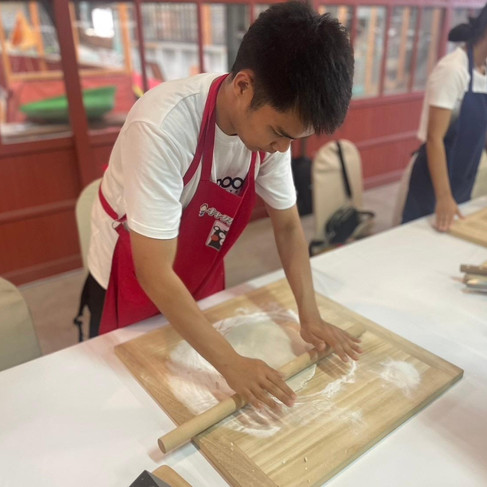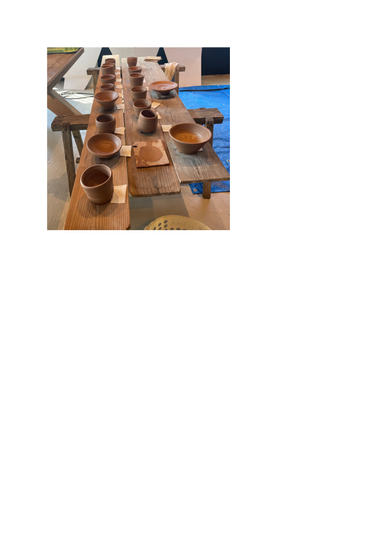This site is available in multiple languages. Please select your preferred language from the bar at the bottom right.
Craft Kyushu | A report from an international student living in Kyushu about the real experiences and excitement of traditional crafts

KAUNG MYAT HTET
Hasami Town Japanese Culture Learning Tour
Day 1: Hasami Town Japanese Culture Learning Tour
As part of a Japanese culture study program for international students attending Nagasaki International University and Nagasaki Junior College, the students visited Hasami Town in Nagasaki Prefecture and participated in the program.

Hasami Town is home to a thriving ceramics industry known as "Hasami ware." This pottery, characterized by its simple designs, traditional manufacturing techniques, and traditional Japanese beauty, is highly regarded on the global market.
First, we visited a ceramics factory to learn about the manufacturing process of Hasami ware. Inside the factory, we were able to see how ceramics are produced using the latest machinery and equipment. We learned that detailed work is carried out in coordination, from preparing the raw materials to molding, finishing, and inspection. We also observed the processing of parts that require cutting and adjustment, drying, and the initial kiln firing process.
At Hasami, we use the latest kilns and production is carried out while carefully adjusting the required temperature and firing time.

Afterwards, the students had the chance to experience making a jumbo pizza themselves, which they then enjoyed for lunch. They systematically learned each step of the process, such as how to stretch the dough and how to shape the pizza, in order to make a delicious pizza.
The jumbo pizza was made with dough, cheese, tomatoes, sliced pork, mushrooms, peppers, and onions. When baking the pizza, they used a Hasami ceramic pizza oven that they had repaired, showing Hasami's unique ingenuity.
It was a valuable learning experience for me.
After lunch, we had the chance to try out making basic pottery ourselves using a pottery wheel or ceramic molding machine, called the "wheel wheel experience." You can choose the shape of your favorite pottery, such as a plate, small dish, or teacup.
The first day's Japanese culture lesson was a full-day learning program where participants gained a lot of knowledge about the Japanese ceramics industry in Hasami Town and were able to learn through hands-on experience.
Day 2: Hasami Town Japanese Culture Study Trip
On the second day of the Japanese culture study program in Hasami Town, the children had the experience of freely painting and decorating ceramic plates and cups made at the Takayama Pottery Factory in Hasami Town with their favorite pictures. After completing their own designs, the plates and cups are fired again at the factory, resulting in shiny, beautifully finished ceramic plates and cups.
Afterwards, the group had the opportunity to visit and tour the museum and community center, which was established to preserve and exhibit the history and culture of Hasami. Inside the center, there are exhibits related to the history of the ceramics industry and the culture of the region, and the center is open to the many tourists who visit as a place where they can learn and interact with each other.
It is also an important place for researchers and tourists who want to learn about history, and plays an important role in passing on and protecting the traditional culture of Hasami Town to future generations. The Cultural Museum not only displays the exhibits, but also interesting replicas of fossils and documents showing the flow of history, making it a very interesting place to see.
After the tour of the museum, we had the opportunity to visit a workshop for making food samples, one of Japan's famous traditional crafts, and experience making them. The purpose of making food samples is to help customers at restaurants understand the appearance and quantity of food. Currently, a food sample making workshop is in operation in Hasami Town, and they are making samples of a dessert called Parfait.
On the third day of the Hasami Japanese Culture Learning Tour, we visited a ceramic teacup manufacturing factory in Hasami Town. For Japanese people, drinking tea from a teacup is one of the customs of Japanese culture. It is common to use ceramic teacups and teapots to brew and drink tea.
On the third day of the program, we had the opportunity to try painting the lids of teacups. You paint your favorite picture or design on the lids, which are not yet fired, then dry and re-fire them to create a beautiful, finished ceramic product. It was a valuable experience to be able to paint a picture and take the work home with you, which made me very happy.
In addition to painting the lids of the teacups, we also had the opportunity to paint the bisque "beckoning cat" dolls in our favorite colors.
Afterwards, we had the opportunity to experience making soba noodles, a rare food in Japan. The teacher carefully explained the process from buckwheat flour to noodles, and we were able to learn each step step by step, such as kneading, stretching, and cutting the noodles.
The kneading process is very important when making soba noodle dough. It is necessary to knead carefully while adjusting the water and flour ratio precisely. After repeated kneading, the dough will have the right firmness and elasticity, and will be ready to be rolled out into a sheet and cut into noodles. Once the dough is well-formed, a knife is used to cut it into thin, even strips.
The cut soba noodles are boiled in hot water for a short time to complete the soba noodles. The boiled noodles are served with mentsuyu (soup). If you like cold soba, we highly recommend you try these soba noodles.
The three-day Japanese culture learning program in Hasami Town, Nagasaki Prefecture was a fun and fulfilling experience through the soba noodle making experience.
Afterwards, together with business operators and residents of Hasami Town, as well as the teachers who supported the three-day learning program, we shared our experiences and impressions of the three days of learning, asked each other questions about points of uncertainty and doubts, and gained a lot of knowledge. It was a very enjoyable time.
Finally, I left Hasami town, thanking the teachers who supported me in every aspect of the three-day study program. This Japanese culture study program, jointly implemented by Nagasaki International University and Nagasaki Junior College, was a valuable opportunity for me to gain many memories and new experiences.
Report
Report language :
Myanmar language










































